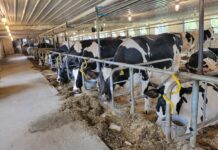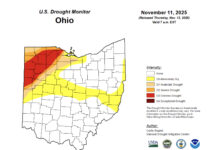WADSWORTH, Ohio – No one testifying at a federal milk marketing hearing in Ohio last week calculated actual losses, but experts estimate that milk producers in Ohio, Michigan, Pennsylvania and Indiana lost approximately $63 million through pool riding from September 2000 through September 2001.
Ohio dairy farmers in Federal Order 33 lost an estimated $20 million; Michigan producers, $26 million; Pennsylvania producers, $8.6 million; and Indiana producers, $8.4 million.
The USDA’s Agricultural Marketing Service held a public hearing Oct. 25 and 26 in Wadsworth, Ohio, to receive testimony on proposals to correct requirements for milk pooling in the Mideast federal order.
Loophole targeted. Milk producers and industry representatives testified hoping to close a loophole that allows milk producers outside the marketing area to “ride” the excess pool value in F.O. 33.
Ten proposed amendments were the subject of the hearing, but first and foremost on everyone’s mind was the issue of “pool riding,” which is an unexpected and unethical, but legal, exploitation of a quirky loophole in the federal order rules.
History. The intent of federal orders has essentially been: To provide a way for milk to be marketed in an orderly way, and to let producers within the order share the proceeds of marketing milk for fluid and manufactured products.
That second point is an important one. Instead of farmers selling to fluid plants being paid $3 or $4 per hundredweight more than farmers selling milk to a cheese or ice cream plant, the “extra” receipts are pooled and divided among producers so milk is marketed equitably within a federal order.
About the pool. Pooling those dollars is done through the federal milk market administrator’s office and shows up in your milk check as the Producer Price Differential (PPD).
The differential is heavily influenced by how milk is used in the order. The higher the proportion of milk that goes into bottled milk (or fluid use), the higher the PPD. In orders where higher proportions of milk are manufactured into cheese and other products, the lower the PPD.
The differential is also influenced by the total hundredweights of milk that the dollars are divided among. More lower value (Class II or IV, as opposed to Class I) hundredweights in the pool mean fewer dollars per hundredweight for any given month’s pooled receipts.
Individual plants or cooperatives may still pay a dairyman more through bonus programs and over-order premiums, but the basic milk price will be equivalent if your milk is going into the bottle or ends up being shrink-wrapped in plastic.
The loophole. There is always some amount of milk moving in and out of an order, particularly along the borders. There is also nothing to stop a dairyman from selling milk anywhere outside of his federal order if he wants to pay to ship it somewhere else. This is done here and there.
Anyone who has chatted with his milk hauler knows that milk has come into our order for years when plants could not get enough local milk to keep the plants running most efficiently. But this milk is purchased directly and is not pooled with the other milk produced in our order. In other words, F.O. 33 PPD dollars did not go back to the dairymen who sold the milk. The dairymen received the PPD in effect for their order.
The loophole that is being exploited, says that to qualify to pool all of a farm’s (located outside of our F.O.) milk production in our federal order, the producer only has to ship a couple days’ production into our order for a few specific months to qualify to pull out PPD dollars on all the milk they produce and sell to someone outside of our order.
As a result of this loophole, milk is now being pooled in F.O. 33 from New Jersey, Iowa, Kansas, Minnesota, North Dakota, South Dakota, Montana and Tennessee.
A few other states have several counties as part of F.O. 33 or have historically pooled a relatively small amount of milk on our order. After federal order reform, they continued to pool milk on the order as well as increase the amount of non-order milk pooled in F.O. 33. These states include Illinois, New York and Wisconsin.
Numbers tell story. The testimony that was presented Tuesday by the market administrator clearly showed the magnitude of the problem. Since June of 2000, 4.1 billion pounds of “producer milk not historically associated with F.O. 33” has been pooled on our order. The impact of that excess milk has caused the Mideast Marketing Area’s Class I utilization to average 47.4 percent for 2000 and drop to 38.3 percent in 2001 (January through August).
As a result of the lower Class I utilization, fewer dollars are available in the pool (less milk used for the highest value products). In addition, the dollars available for pooling were divided over 41 million more hundredweights of milk and sent to producers who delivered less than 3 percent of the milk to F.O. 33.
That’s right, of the 4.1 billion pounds of milk pooled on our order, less than 3 percent, or 113 million pounds, were actually loaded on a truck, hauled here and processed.
Adding insult to injury. Ohio is a milk deficit area. In other words, in times of short supplies, handlers have to go outside the order to buy milk to keep plants here running at capacity. Now, with the 4.1 billion pounds we are paying PPDs for, there should be some reciprocity, wouldn’t you think?
No, according to testimony from Ann Rady, office manager for Foremost Farms in Indiana, who has spent the last 25 years in milk procurement.
“Milk is not more available on F.O. 33 with pool riding, (it is) still necessary to pay “give up” fees. It is not unusual for them to be in the $3 per hundredweight range.”
Hearing. Kudos to (in the order they testified) Jack Groselle of Hiram; Earl Stitzlein from northwestern Holmes County, representing the 200 dairy farm members of the Independent Dairy Producers Association; and Larry Baer, dairyman from Marshallville, Ohio.
Every dairyman in Federal Order 33 should shake the hands of these three Ohio dairymen who testified. Each had to take the time to study the issue, prepare their thoughts and testimony and respond to questions and cross examination. While they testified on behalf of themselves and/or groups of dairymen, they represented us all exceptionally well.
DFA pushes change. In addition to these three dairymen, testimony was heard from the F.O. 33 market administrator, Michigan Milk Producers Association, Prairie Farms, Foremost Farms, Continental Dairy Producers Inc. and Dairy Farmers of America who had two witnesses testify.
Credit goes to DFA for its honesty (you are sworn in and testify under oath). The milk marketing co-op did not try to hide the fact that it has been “pool riding” to the benefit of its members outside of F.O. 33 and to the detriment of those members in F.O. 33.
The DFA representatives also testified that it is a practice that is “….detrimental to our members, our customers and the entire federal order system. We plan to express that concern in other federal order hearings and seek a solution that is consistent and in line with federal order principles system wide.”
DFA rationalized its participation in pool riding with the statement, “Indeed, in the competitive dairy economy if a competitor makes a pooling decision that results in increased funds, you must attempt to do the same or face a more difficult competitive position. Individual organizations cannot unilaterally disarm.”
Land O’Lakes mum. Land O’Lakes was conspicuously absent from the list of dairy organizations presenting proposed amendments to close the loophole.
While it has moved its business into Ohio through mergers with Countrymark and Purina, the questions raised by the LOL attorney did not seem to lean toward the need to keep F.O. 33 PPDs going to milk that is actually shipped into and processed in the order.
Proposed amendments focused not on ending the practice, but tightening up the actual delivery requirements to the point where it would likely be a break-even or money-losing process to try to ride a pool outside of your own order.
Other orders affected. Interestingly, this pool-riding situation is not limited to F.O. 33. There are five federal orders (out of 11) holding hearings. Ironically, one of those orders includes Wisconsin, who historically pooled between 1 to 1.7 million pounds of milk per month on F.O. 33. Since January of this year, they have been pooling an average of 348 million pounds per month.
Why a federal order hearing in their own backyard? Seems they are upset because some Idaho dairymen have been riding their pool.
(The author is the northeast Ohio district dairy specialist with OSU Extension. Send comments or questions in care of Farm and Dairy, P.O. Box 38, Salem, OH 44460.)












